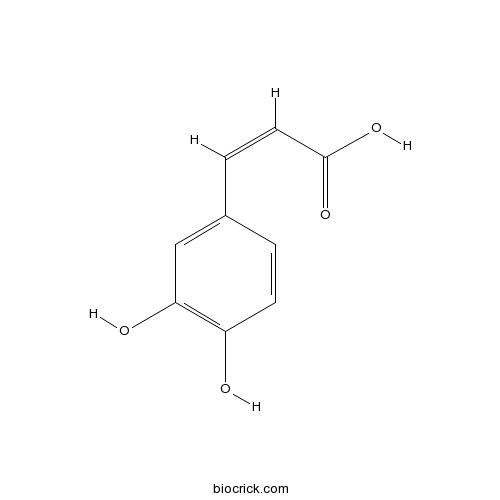Polygonum chinense
Polygonum chinense
1. The products in our compound library are selected from thousands of unique natural products; 2. It has the characteristics of diverse structure, diverse sources and wide coverage of activities; 3. Provide information on the activity of products from major journals, patents and research reports around the world, providing theoretical direction and research basis for further research and screening; 4. Free combination according to the type, source, target and disease of natural product; 5. The compound powder is placed in a covered tube and then discharged into a 10 x 10 cryostat; 6. Transport in ice pack or dry ice pack. Please store it at -20 °C as soon as possible after receiving the product, and use it as soon as possible after opening.
Natural products/compounds from Polygonum chinense
- Cat.No. Product Name CAS Number COA
-
BCN5979
Caffeic acid331-39-5
Instructions

-
BCN5551
Isorhamnetin480-19-3
Instructions

-
BCN5699
Syringic acid530-57-4
Instructions

-
BCN5771
Avicularin572-30-5
Instructions

Anticomplement compounds from Polygonum chinense.[Pubmed: 29631958]
None
Characterization and mechanisms of anti-influenza virus metabolites isolated from the Vietnamese medicinal plant Polygonum chinense.[Pubmed: 28327126]
Polygonum chinense Linn. is a common medicinal plant in Southeast Asia and has been used in traditional medicine in Vietnam. The plant contains phytochemicals with various biological properties; however, its antiviral effect has not yet been demonstrated. This study was aimed to evaluate the anti-influenza virus activity of crude extracts of P. chinense, to characterize antiviral metabolites therefrom and to investigate their mechanisms of antiviral action.
Endophytic fungi from tropical ethnoveterinary plants and their antibacterial efficacy against Pasteurella multocida Capsular Type A strain.[Pubmed: 29451766]
Pasteurella multocida is an important veterinary pathogen causing infections in animals and birds. Nowadays, different reports have described the severity of infections, increasing resistance of micro-organisms to antibiotics, and the contribution of ethnoveterinary practices towards the treatment of various ailments of animals. The aim of the present study was to investigate the antibacterial efficacy of the ethanolic extracts of endophytic fungi against P. multocida Capsular Type A strains. A total of six endophytic fungi were isolated from two tropical ethnoveterinary plants: Garcinia xanthochymus H. and Polygonum chinense L. The ethanolic extracts of the endophytic fungi were subjected to in vitro antimicrobial activity by the well diffusion method. Besides, we evaluated the treatment of mice with the potent fungal extract and observed the effects in different organs under electron microscopy. Our results showed that four fungi had antimicrobial activity against the selected pathogen. The best antibacterial activity was showed by the extract of the endophytic fungi, Glomerella magna isolated from G. xanthochymus, with a minimum inhibitory concentration of 46.9 μg/mL and minimum bactericidal concentration of 750 μg/mL. Treatment of mice with the potent fungal extract caused a considerable inhibitory effect on the pathogen growth in vital organs, results that was also confirmed by histopathological studies made by scanning electron microscopy. The present findings indicated that the endophytic fungi G. magna has the potential to provide an effective treatment against infections caused by Pasteurella multocida. However, the isolation of bioactive components needs further investigation.
A bioactivity-guided study on the anti-diarrheal activity of Polygonum chinense Linn.[Pubmed: 23895917]
Polygonum chinense Linn., a folk medicine, has long been used for the treatment of diarrhea and enteritis in southwestern China. However, the components responsible for its anti-diarrheal activity are still poorly understood.
Gastroprotective Activity of Polygonum chinense Aqueous Leaf Extract on Ethanol-Induced Hemorrhagic Mucosal Lesions in Rats.[Pubmed: 23365597]
Polygonum chinense is a Malaysian ethnic plant with various healing effects. This study was to determine preventive effect of aqueous leaf extract of P. chinense against ethanol-induced gastric mucosal injury in rats. Sprague Dawley rats were divided into seven groups. The normal and ulcer control groups were orally administered with distilled water. The reference group was orally administered with 20 mg/kg omeprazole. The experimental groups received the extracts 62.5, 125, 250, and 500 mg/kg, accordingly. After sixty minutes, distilled water and absolute ethanol were given (5 mL/kg) to the normal control and the others, respectively. In addition to histology, immunohistochemical and periodic acid schiff (PAS) stains, levels of lipid peroxidation, malondialdehyde (MDA), antioxidant enzymes, and superoxide dismutase (SOD) were measured. The ulcer group exhibited severe mucosal damages. The experimental groups significantly reduced gastric lesions and MDA levels and increased SOD level. Immunohistochemistry of the experimental groups showed upregulation and downregulation of Hsp70 and Bax proteins, respectively. PAS staining in these groups exhibited intense staining as compared to the ulcer group. Acute toxicity study revealed the nontoxic nature of the extract. Our data provide first evidence that P. chinense extract could significantly prevent gastric ulcer.
GC-MS analysis of phytocomponents in the ethanol extract of Polygonum chinense L.[Pubmed: 22224055]
The presence of diverse secondary metabolites has been reported from species of the genus Polygonum. However, there has been not much information available on phytochemical components and biological activity in the whole plant ethanol extract of Polygonum chinense L.


